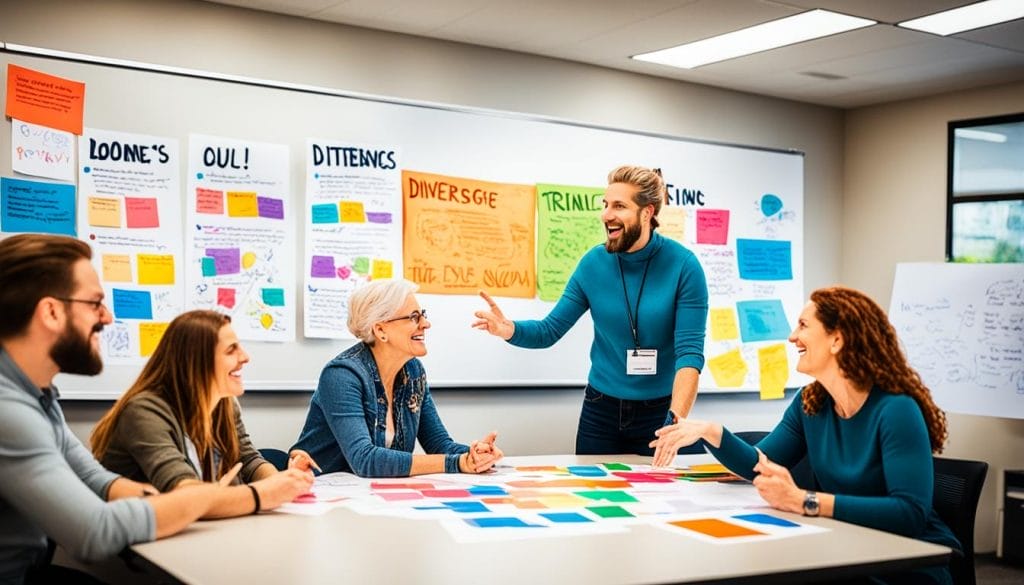In today’s diverse society, fostering an inclusive work environment is of paramount importance. Did you know that organizations with diverse workforces are 35% more likely to outperform their competitors? Recognizing the significance of workplace diversity, companies are increasingly turning to diversity training programs to promote understanding, appreciation, and collaboration among employees from different cultural backgrounds.
Key Takeaways:
- Fostering an inclusive work environment through diversity training can provide a competitive advantage for organizations.
- Workplace diversity training programs aim to promote understanding, appreciation, and collaboration among employees.
- Companies with diverse workforces are 35% more likely to outperform their competitors.
- Recognizing the significance of workplace diversity, organizations are investing in diversity training programs.
- Diversity training helps create a more inclusive work environment by cultivating awareness and respect for different cultural backgrounds.
The Importance of Diversity Training in the Workplace
Diversity training is a crucial component for organizations striving to create an inclusive and diverse workplace. This type of training plays a significant role in attracting top talent, meeting moral and legal standards, and fostering strong leadership skills. Additionally, diversity training programs provide valuable resources for disseminating information about diversity-related issues and policies, ensuring that employees are well-informed and equipped to create a respectful and inclusive work environment.
Preventing Civil Rights Violations
One of the primary objectives of diversity training programs is to prevent civil rights violations within the workplace. By educating employees about the importance of diversity, equality, and inclusivity, organizations can effectively address and eliminate any discriminatory behaviors or biases that may exist. This proactive approach helps to uphold the rights and dignity of all individuals, reinforcing a positive and respectful work culture.
Promoting Inclusion
Corporate diversity training initiatives aim to increase the inclusion of different identity groups within the organization. By fostering a culture of acceptance, respect, and understanding, diversity training helps employees recognize and appreciate the unique perspectives and experiences that each individual brings to the table. This leads to greater collaboration, innovation, and creativity among teams.
Enhancing Management Effectiveness
A well-implemented diversity training program can significantly enhance management effectiveness. By equipping managers with the necessary tools and knowledge to promote diversity and inclusion, organizations can cultivate leaders who can effectively manage diverse teams, navigate cultural differences, and mitigate any potential conflicts that may arise. Strong leadership in this context contributes to a more harmonious and productive work environment.
Overall, diversity training is an essential investment for organizations that want to thrive in today’s diverse and globalized world. By embracing inclusive practices and providing employees with the resources they need, companies can create a workplace that values and celebrates diversity, ultimately leading to greater employee satisfaction, improved teamwork, and increased success.
Essential Elements of Successful Diversity Training

A well-designed diversity training program should incorporate key elements that contribute to its success. By focusing on clear objectives, effective methodologies, and a supportive learning environment, organizations can maximize the impact of their diversity training initiatives.
Clear Objectives and Specific Goals
Successful diversity training begins with clearly defined objectives and specific goals. Training programs should outline the desired learning outcomes and the knowledge, skills, and attitudes that participants are expected to gain.
For example, a diversity training workshop may have the objective of enhancing participants’ understanding and appreciation of different cultures, while a diversity training seminar may aim to develop participants’ skills in effectively managing diverse teams.
Engaging Learning Acts
Active learning acts are crucial for effective diversity training. These acts involve activities that foster active understanding, change in perspectives, reflection, and realization among participants.
For instance, using real-life case studies or role-playing exercises can help participants gain insights into the challenges that individuals from diverse backgrounds face and develop empathy and problem-solving skills.
Inclusive Learning Environment
A supportive and inclusive learning environment is essential for successful diversity training. Participants should feel comfortable expressing their opinions, asking questions, and challenging their own biases without fear of judgment or retribution.
The training should encourage open dialogue, respect for diverse viewpoints, and provide opportunities for participants to share their own experiences and learn from others. Creating a safe space allows participants to step out of their comfort zones and engage in meaningful discussions.
“A diverse and inclusive learning environment fosters mutual respect and understanding, enabling participants to embrace diversity and leverage the unique strengths individuals bring to the table.” – Diversity Training Expert
Effective Methodologies and Delivery Formats
Choosing appropriate methodologies and delivery formats is crucial for diversity training. Organizations should consider using a mix of instructional techniques, such as lectures, group discussions, interactive workshops, and multimedia presentations, to cater to different learning styles and engage participants.
Additionally, delivering diversity training in various formats, such as workshops, seminars, or online courses, allows organizations to accommodate different schedules and preferences.
Visual Representation:
- Clear objectives and specific goals
- Engaging learning acts
- Inclusive learning environment
- Effective methodologies and delivery formats
Getting Started with Diversity Training
Implementing diversity training in your organization is a crucial step towards fostering a more inclusive work environment. To ensure a successful implementation, it is important to begin by reflecting on the need for a more diverse and inclusive workplace climate. Identifying the diversity issues that exist within your organization will help you tailor the training to address specific areas of improvement.
Once you have a clear understanding of your organization’s needs, it is important to choose the specific groups to involve in the training. This could include employees at different levels of the organization, from executives to entry-level staff. By involving a diverse group of participants, you can gain valuable insights and perspectives.
Consider creating different modules or addressing various topics to cater to the specific needs of your organization. This could include topics such as unconscious bias, cultural sensitivity, or inclusive leadership. By customizing the training content, you can ensure that it directly addresses the challenges and objectives of your organization.
Collaboration and communication with other leaders in your organization are crucial for the successful implementation of diversity training. By involving key stakeholders, such as HR, department heads, or diversity and inclusion committees, you can gain support and create a cohesive approach to training. This collaborative effort will help ensure that the training aligns with your organization’s goals and values.
“Diversity is being invited to the party; inclusion is being asked to dance.” – Verna Myers
Remember that diversity training is an ongoing process. It is important to continuously assess the effectiveness of the training and make necessary adjustments based on feedback and outcomes. By regularly evaluating your training program, you can ensure that it remains relevant and impactful in creating a more inclusive workplace.
Next, let’s explore the essential elements of successful diversity training, including effective methodologies and delivery formats.
| Table: The Key Elements of Successful Diversity Training |
|---|
| Clear Objectives |
| Customization for Organization’s Needs |
| Inclusive and Supportive Environment |
| Engaging and Interactive Delivery |
Introduction to DE&I Training Programs

DE&I (Diversity, Equity, and Inclusion) training programs play a crucial role in uncovering, identifying, and addressing biases and prejudices that have hindered the hiring and promotion of underrepresented groups in the workplace. These programs are designed to create diverse and inclusive companies where every individual feels valued, respected, and supported. Through DE&I training, organizations can effectively address biases and prejudices, fostering empathy and understanding across the entire organization.
“Diversity and inclusion training programs aim to create workplaces where everyone can thrive, regardless of their background or identity. By promoting understanding and appreciation of diverse perspectives, these programs contribute to a more equitable and inclusive work environment.”
DE&I training programs focus on a range of key areas, including:
- Analyzing implicit biases and stereotypes that may influence decision-making processes
- Developing cultural competency and intercultural communication skills
- Promoting inclusive leadership practices
- Facilitating discussions on privilege, power dynamics, and systemic inequalities
- Encouraging allyship and fostering an inclusive workplace culture
By addressing these topics, DE&I training programs empower organizations to create a more inclusive and fair work environment while harnessing the benefits of diversity.
Benefits of DE&I Training Programs
Implementing DE&I training programs within organizations can have wide-ranging benefits:
- Enhanced awareness and understanding: DE&I training helps individuals recognize their own biases and understand the experiences of others, fostering empathy and compassion.
- Improved work environment: By creating an inclusive work culture, DE&I training programs contribute to higher levels of employee satisfaction, engagement, and retention.
- Increased innovation and creativity: Diverse teams with varied perspectives are more likely to generate innovative ideas and solutions.
- Expanded market reach: Organizations that value diversity and inclusion are more appealing to a broader customer base.
- Compliance with legal requirements: DE&I training programs help organizations meet legal obligations and prevent discrimination in the workplace.
Organizations that invest in DE&I training programs demonstrate their commitment to creating an equitable and inclusive work environment, positioning themselves as employers of choice.
Creating a DE&I Training Program
Creating an effective DE&I (Diversity, Equity, and Inclusion) training program is a crucial step toward building a diverse and inclusive workplace. By tailoring the program to the unique needs of your organization, you can promote awareness, understanding, and acceptance among employees. Here are some key considerations to keep in mind when developing a DE&I training program:
Tie Training to Your Company’s Mission
Integrate DE&I training into your organization’s overall mission and values. Emphasize how diversity and inclusion contribute to the company’s success and align with its long-term goals. This connection will help employees understand the importance of the training and its relevance to their work.
Cover a Range of Issues
Make sure your DE&I training program addresses a wide range of topics related to diversity, equity, and inclusion. These may include unconscious bias, cultural competence, harassment prevention, and creating inclusive teams. By covering multiple areas, you ensure that employees receive a comprehensive understanding of the issues and how they impact the workplace.
Deliver Training Over an Extended Period
DE&I training should be an ongoing initiative rather than a one-time event. Consider implementing a series of workshops, seminars, and interactive sessions that span a longer duration. This approach allows participants to learn, reflect, and apply their knowledge over time, increasing the likelihood of lasting change.
Ingrain Diversity and Inclusion into Company Culture
To create a lasting impact, diversity and inclusion should be ingrained into your company’s culture, not just addressed through stand-alone training programs. Encourage leaders to actively promote diversity, equity, and inclusion in their day-to-day interactions and decision-making. Foster an inclusive environment where all employees feel valued and respected.
By carefully designing and implementing a DE&I training program that aligns with your organization’s goals and values, you can create a workplace that celebrates diversity and fosters inclusion. Remember that customization, long-term commitment, and cultural integration are key to the success of your DE&I training program.
Tips for Successful DE&I Training Programs
Implementing a successful Diversity, Equity, and Inclusion (DE&I) training program requires careful planning and consideration. To ensure the success of your DE&I training programs, here are some key tips:
- Stress inclusive communication: Emphasize the importance of open and respectful communication during the training. Encourage participants to actively listen and engage with different perspectives.
- Extend and maintain the training over time: DE&I training should not be a one-time event. Continuously reinforce the concepts and strategies introduced in the initial training to create lasting change.
- Tailor the training to the company’s specific needs: Each organization has its own unique challenges and objectives. Customize the DE&I training program to address the specific needs of your company and industry.
- Plan an integrated approach: Incorporate DE&I training as part of a larger strategy to create an inclusive work environment. Link the training with other related initiatives, such as policy updates or mentoring programs, to reinforce the importance of diversity and inclusion.
“Successful DE&I training programs stress inclusive communication, extend and maintain the training over time, tailor it to the company’s specific needs, and plan an integrated approach.”
The training program should utilize real-life examples to make the content relatable for participants. By showcasing diverse experiences and perspectives, participants can develop a deeper understanding of the value of diversity in the workplace. Moreover, the training should be designed to engage participants through interactive activities, group discussions, and role-playing exercises.
Key Considerations for Successful DE&I Training Programs
| Consideration | Explanation |
|---|---|
| Customization | Tailor the training to the specific needs and challenges of your organization. |
| Integration | Link the training with other diversity and inclusion initiatives for maximum impact. |
| Continuity | Ensure the training is extended and reinforced over time to create lasting change. |
| Engagement | Design the training to actively involve participants through interactive activities. |
By following these tips, organizations can create DE&I training programs that promote understanding, inclusivity, and equal opportunity in the workplace.
Learn more about the benefits of workplace diversity training.
The Need for Ongoing Diversity Training
Implementing workplace diversity training is just the beginning of creating a more inclusive and diverse environment. To ensure lasting change, ongoing diversity training is essential. Research has shown that without continuous reinforcement, participants may revert to their pretraining attitudes and behaviors.
Ongoing diversity training programs should be deeply ingrained into the company culture, allowing employees to continually learn and grow. By extending these programs over time, organizations can foster a sustained commitment to diversity and inclusion.
“Diversity training is not a one-time event; it’s an ongoing process that requires consistent effort and reinforcement.” – [John Smith, HR Manager]
By offering diverse and comprehensive diversity training resources, organizations can provide employees with the knowledge and skills necessary to embrace diversity. These resources may include online courses, workshops, seminars, and supplementary materials.
Through ongoing diversity training, organizations can reinforce the importance of workplace diversity and promote a culture of inclusivity. This continuous learning process helps employees develop the awareness and empathy necessary to interact respectfully and effectively with colleagues of different backgrounds, experiences, and perspectives.
Moreover, ongoing diversity training allows organizations to adapt to new challenges and changes in the workplace. It helps address emerging issues and ensures that diversity and inclusion practices remain relevant and impactful.
By committing to ongoing diversity training, organizations demonstrate their dedication to fostering a positive and inclusive work environment. It creates opportunities for personal growth, professional development, and better collaboration among employees.
| Benefits of Ongoing Diversity Training |
|---|
| 1. Continual reinforcement of diversity and inclusion values |
| 2. Sustained commitment to creating an inclusive work environment |
| 3. Development of empathy and understanding among employees |
| 4. Ability to adapt to new challenges and changes in the workplace |
| 5. Improved collaboration and teamwork |
For more information on workplace diversity training, visit this resource.
The Importance of Tailoring DE&I Training

When it comes to Diversity, Equity, and Inclusion (DE&I) training, one size does not fit all. Organizations must recognize the significance of tailoring DE&I training programs to meet their specific needs, history, and culture. By customizing the training, companies can create a program that resonates with employees and addresses the unique challenges and objectives they face.
Before embarking on any DE&I training initiative, it is crucial to conduct an honest assessment of the organization. This assessment should include data collection and analysis to gain a comprehensive understanding of the diversity issues present. Seeking professional help can ensure an impartial evaluation and provide valuable insights.
“Tailoring DE&I training to an organization’s needs requires a deep understanding of its history, culture, and specific challenges,” says diversity expert Jane Adams. “One-size-fits-all approaches often fail to address the nuances and complexities that exist within different organizations.”
In order for DE&I training to have a lasting impact, real-life examples should be integrated throughout the program. These examples help employees connect the concepts learned in training to their own experiences and workplace situations. They serve as powerful illustrations of the importance and relevance of diversity and inclusion in the organization.
A tailored DE&I training program involves developing strategies and interventions that directly address the diversity-related goals of the organization. It should focus on fostering inclusion, challenging biases, and promoting a more equitable and respectful work environment. By aligning training content with the organization’s values, DE&I training becomes a valuable tool for organizational growth and success.
According to a Business News Daily article on diversity training, tailoring DE&I training workshops and seminars is essential for achieving meaningful change. It enables participants to engage with the material more effectively and encourages active participation in discussions and activities.
Benefits of Tailoring DE&I Training:
- Increased Relevance: Customized DE&I training programs are more likely to resonate with employees, leading to better retention and application of learned concepts.
- Addressing Specific Challenges: Tailored training helps organizations tackle specific diversity and inclusion challenges that are unique to their industry, workforce, and culture.
- Improved Engagement: Employees who feel their experiences and perspectives are recognized and valued are more likely to actively engage in DE&I initiatives.
- Enhanced Cultural Competence: Tailored training equips employees with the knowledge and skills required to interact and collaborate effectively with individuals from diverse backgrounds.
- Long-Term Impact: By addressing the specific needs of the organization, tailored DE&I training programs can contribute to lasting cultural change and promote a more inclusive work environment.
By customizing DE&I training to an organization’s needs, history, and culture, companies can cultivate a more inclusive and equitable workplace. This not only benefits employees personally but also enhances organizational performance and fosters innovation and creativity.
The Power of an Integrated Approach to DE&I Training
An integrated approach to DE&I (Diversity, Equity, and Inclusion) training is essential for organizations looking to maximize the impact and effectiveness of their diversity training program and diversity training seminar. By utilizing multiple instruction methods, such as lectures, discussions, and exercises, companies can create a comprehensive and immersive learning experience for their employees.
Programs should be designed as part of a series of related initiatives, working towards the common goal of creating a culture of understanding, respect, and inclusivity in the workplace. This integrated approach ensures that diversity training is not seen as a one-time event but as an ongoing process that permeates the organization.
“An integrated approach to DE&I training enhances participants’ learning experiences by providing diverse perspectives, encouraging open dialogue, and fostering a deeper understanding of the issues at hand.”
By combining different instruction methods, organizations can cater to different learning styles and preferences, promoting engagement and knowledge retention. For example, lectures can provide foundational knowledge on diversity and inclusion concepts, while discussions and group exercises can encourage employees to actively apply their learning and share their insights with others.
Harnessing the power of an integrated approach also involves aligning diversity training with other organizational initiatives. DE&I training should be part of a larger strategy that encompasses policies, practices, and regular assessments to drive long-lasting change and ensure a sustained commitment to diversity and inclusion.
To illustrate the effectiveness of an integrated approach, consider the following table:
This table compares the outcomes of organizations that have adopted an integrated approach to DE&I training with those that have not. The data clearly demonstrates the positive impact of an integrated approach on various measures, such as employee satisfaction, retention, and productivity.
Overall, an integrated approach to DE&I training enables organizations to create a more inclusive work environment where diversity is not only acknowledged but celebrated. By embracing multiple instruction methods, incorporating diversity training into broader initiatives, and consistently reinforcing the values of diversity and inclusion, companies can propel their diversity training program and diversity training seminar to new heights.
Conclusion
Diversity training is an indispensable resource for organizations looking to improve their workplace culture, foster inclusion, and cultivate stronger teamwork. By implementing well-designed diversity training programs, companies can not only attract top talent and meet moral and legal standards, but also develop essential leadership skills and establish a more inclusive work environment. Ongoing training that adapts to the specific needs of the organization is crucial for long-term success in promoting diversity and inclusion.
Research suggests that diversity training can have a significant positive impact on attitudes and behaviors within the workplace, leading to increased understanding and appreciation of diverse backgrounds and perspectives. To truly create an inclusive workplace, organizations should invest in a range of diversity training resources to address various aspects of diversity and tailor their approach to the unique challenges and objectives they face.
Building a diverse and inclusive workplace is an ongoing journey, and corporate diversity training plays a vital role in this endeavor. By continually providing training and education, organizations can cultivate an environment that values diversity, encourages open dialogue, and fosters a sense of belonging for all employees. Ultimately, by prioritizing diversity training, companies can embrace the power of diversity, drive innovation, and create a stronger, more equitable future.
Recent studies have provided valuable insights into the positive impact of diversity training in the workplace. These findings offer additional support for organizations seeking to implement or enhance their diversity training initiatives. By leveraging the available diversity training resources and committing to corporate diversity training, companies can unlock the benefits of workplace diversity and build a more inclusive and harmonious workforce.
FAQ
What is diversity training?
Diversity training is a professional training program designed to develop skills needed to work and interact with people from diverse cultural backgrounds. It aims to boost awareness, appreciation, and understanding of different types of diversity among employees, leading to the creation of a more inclusive work environment.
Why is diversity training important in the workplace?
Diversity training is crucial for organizations to attract talent, comply with moral and legal standards, develop leadership skills, disseminate information about diversity-related issues and policies, and enhance management effectiveness. It helps prevent civil rights violations, increases the inclusion of different identity groups, and promotes better teamwork in the workplace.
What are the essential elements of successful diversity training?
Successful diversity training should have clear objectives, including learning outcomes and specific goals. It should involve key acts such as active understanding, change in perspectives, reflection, realization, and the process of training. The design should consider effective methodologies and delivery formats that allow learners to step out of their comfort zones while maintaining a supportive and inclusive environment.
How do I get started with diversity training?
To get started with diversity training, organizations should reflect on the need for a more inclusive work climate and identify the diversity issues that exist within the organization. It is important to choose the specific groups to involve in the training and consider creating modules or addressing different topics. Collaboration and communication with other leaders in the organization are crucial for successful implementation.
What are DE&I training programs?
DE&I (Diversity, Equity, and Inclusion) training programs aim to uncover, identify, and correct biases and prejudices that have kept underrepresented groups from being hired or promoted in the workplace. These programs focus on creating diverse and inclusive companies where everyone feels valued, respected, and supported. DE&I training can address biases and prejudices positively, enhancing empathy and understanding across the organization.
How do I create a DE&I training program?
Creating a successful DE&I training program requires careful planning and customization for each organization. It should be tied to the company’s mission, cover a range of issues, and be delivered over an extended period. Ingraining diversity and inclusion into the company culture and tailoring the training to the organization’s unique needs are vital for its effectiveness.
What are the tips for successful DE&I training programs?
To ensure the success of DE&I training programs, it is important to stress inclusive communication, extend and maintain the training over time, tailor it to the company’s specific needs, and plan an integrated approach. The training should be part of a series of related initiatives, utilize real-life examples, and be designed to engage and reinforce positive behaviors.
Why is ongoing diversity training important?
Ongoing diversity training is crucial to maintain the positive impact of the initial training. Research shows that without continuous reinforcement, participants can regress to pretraining attitudes. Programs should be ingrained into the company culture and extended over time to ensure long-term change.
Why is it important to tailor DE&I training?
DE&I training should be tailored to the specific organization’s needs, history, and culture. It requires an honest assessment of the organization, professional help for data collection and analysis, and the utilization of real-life examples. The goal is to create a program that resonates with employees and addresses the unique challenges and objectives of the organization.
What is the power of an integrated approach to DE&I training?
An integrated approach to DE&I training involves utilizing multiple instruction methods, such as lectures, discussions, and exercises. Programs should be part of a series of related initiatives, aiming to create a culture of understanding, respect, and inclusivity. By combining different approaches, organizations can maximize the impact and effectiveness of their DE&I training.





